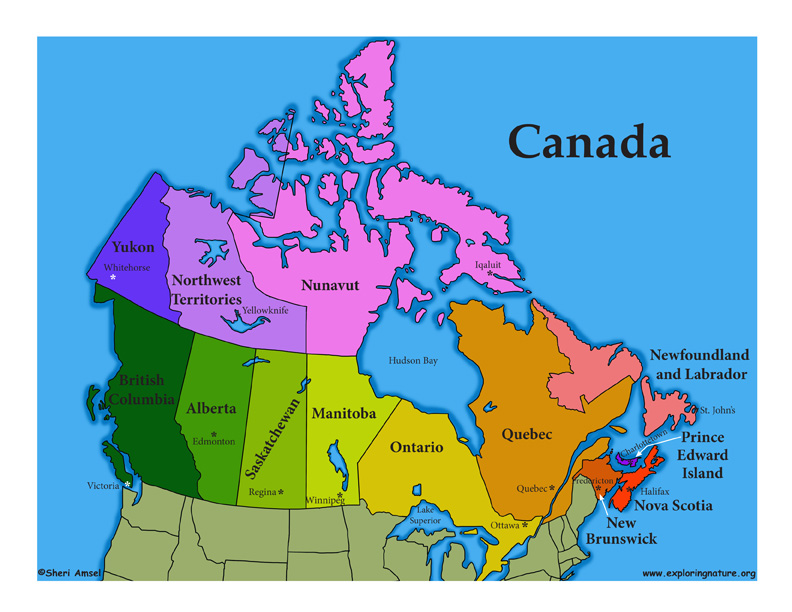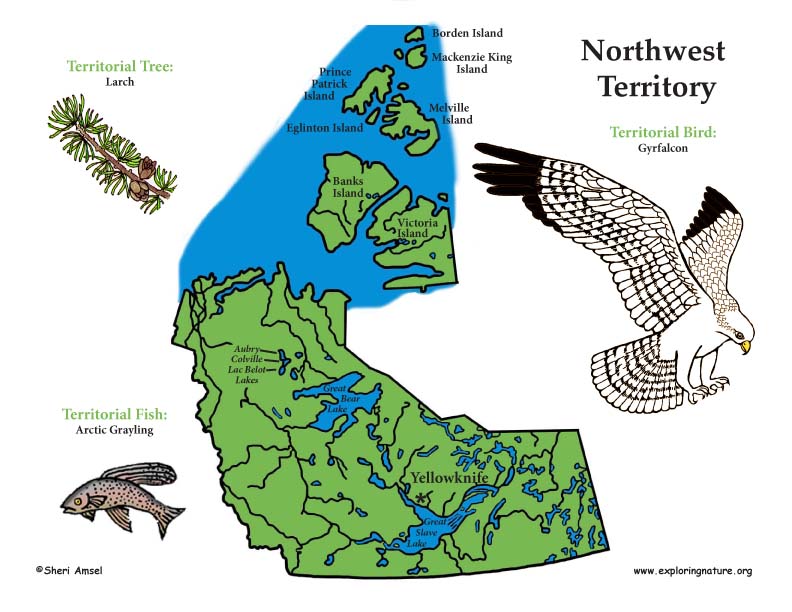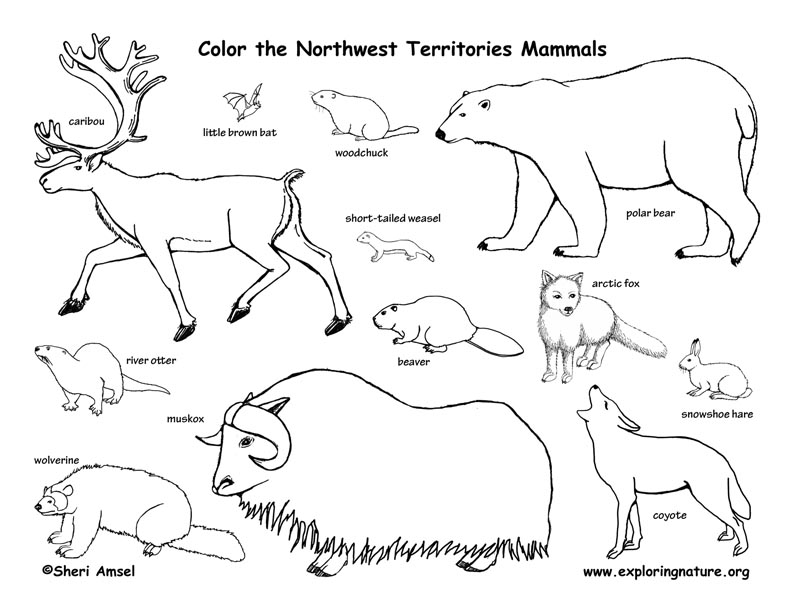

The Northwest Territories is in northern Canada and is surrounded by the Yukon to the west, British Columbia, Alberta and Saskatchewan to the south, and Nunavut to the east and north. It is made up of 320 million acres (500,000 square miles or 1,183,085 square km) of boreal forest - that makes up 17% of all of Canada's boreal forest. It is also rich with wetlands – peatlands, bogs, lakes, and rivers and provides important breeding grounds for millions of birds. It is home to a huge herd of barren ground caribou, a smaller herd of woodland caribou and their predators – the gray wolf.
The capital is Yellowknife.
The Northwest Territories is huge, so to describe its landscape, climate and habitats, scientists break it down into "Ecozones."
The Taiga Cordillera Ecozone is the subarctic region along the northern Rocky Mountains on the western border. This ecozone hosts some of Canada's most spectacular scenery - wild rivers, stunning waterfalls, and deep canyons. In the north the landscape is covered in tundra – low shrubs, lichens and mosses. As you travel south, it turns to boreal forest with alpine tundra topping the mountains. This varied landscape supports Dall sheep, caribou, mountain goat, moose, black and grizzly bear, wolf, Canada lynx, wolverine, pika, and marmot.
The Taiga Plains Ecozone makes up the central core of the Northwest Territories. This is a cold, dry prairie with some river canyons along the MacKenzie River. This is a region that experiences fires regularly, so supports fire tolerant species like paper and dwarf birch, willows, quaking aspen, tamarack, green alder, white and black spruces, balsam poplar, lodgepole and jack pines, and balsam fir. This region supports fewer mammals, but does include black bear, lynx, wolf, red fox, ermine, marten, woodland and barren-ground caribous, wood bison, moose, snowshoe hare, red squirrel, and arctic ground squirrel.
The Taiga Shield Ecozone is a region of boreal forest that makes up much of the central to southeast portion of the Territory. This flat, wet, coniferous forest region has long, cold winters and is the transition zone between the boreal forest and the Arctic. It is dotted with millions of lakes, left by the retreat of the glaciers, and bogs, making it a popular breeding ground for waterfowl. It's thought that more than 200 species of birds breed here - perhaps 500 million birds! The forest includes: black and white spruce, jack pine, green alder, paper, white and dwarf birch, tamarack, balsam fir, quaking aspen, and balsam poplar. The region supports animals that can tolerate subarctic conditions, including black and grizzly bears, wolf, lynx, moose, barren-ground and woodland caribou, coyote, weasel, wolverine, river otter, red and arctic fox, muskrat, marten, mink, beaver, vole, red squirrel, and snowshoe hare. Humans mine ore and explore for oil in this region.
The Southern Arctic Ecozone spreads across northern Canada and makes up the northeast corner and all long the northern border of the Northwest Territories. Here, the winters are long, dark and frigid (-18° F/-28°C) and summers are short and cool (42° F/6°C) with long daylight hours. Due to the extensive permafrost, only hardy plants survive here, like stunted trees, shrubs, lichens and mosses. Wetlands along the coast provide breeding and nesting grounds for waterfowl and barren ground caribou (from the Porcupine herd) have their calves on the open tundra. Other hardy wildlife also make a living here, like: polar bear, muskox, and arctic fox.
Mammals:
bat (hoary) - Lasiurus cinereus
bat (little brown) - Myotis lucifugus
bat (northern long-eared) - Myotis septentrionalis
bear (black) - Ursus americanus
bear (grizzly) - Ursus arctos
bear (polar) - Ursus maritimus
beaver (American) - Castor canadensis
bison (wood) - Bison bison athabascae
caribou (barren-ground) - Rangifer articus
caribou (woodland) - Rangifer tarandus
chipmunk (least) - Tamias minimus
coyote - Canis latrans
deer (mule) - Odocoileus hemionus
deer (white-tailed) - Odocoileus virginianus
elk - Cervus canadensis
fisher - Martes pennanti
fox (Arctic) - Vulpes lagopus
fox (red) - Vulpes vulpes
hare (Arctic) - Lepus arcticus
hare (snowshoe) - Lepus americanus
lemming (brown) - Lemmus trimucronatus
lemming (pearly land collared) - Dicrostonyx groenlandicus
lemming (Richardson's) - Dicrostonyx richardsoni
lemming (Victoria Collared) - Dicrostonyx kilangmiutak
lynx (Canadian) - Lynx canadensis
marmot (Hoary) - Marmota caligata
marten (American) - Martes americana
mink (American) - Neovison vison
moose - Alces alces
mountain Goat - Oreamnos americanus
mountain Lion (cougar) - Puma concolor
mouse (deer) - Peromyscus maniculatus
mouse (meadow jumping) - Zapus hudsonius
muskox - Ovibos moschatus
muskrat (common) - Ondatra zibethicus
otter (North American River) - Lontra canadensis
Pika (collared) - Ochotona collaris
porcupine (North American) - Erethizon dorsatum
raccoon - Procyon lotor
sheep (Dall's) - Ovis dalli
shrew (American water) - Sorex palustris
shrew (Arctic) - Sorex arcticus
shrew (barren ground) - Sorex ugyunak
shrew (dusky) - Sorex monticolus
shrew (masked) - Sorex cinereus
shrew (pygmy) - Sorex hoyi
shrew (tundra) - Sorex tundrensis
skunk (striped) - Mephitis mephitis
squirrel (Arctic ground) - Spermophilus parryii
squirrel (northern flying) - Glaucomys sabrinus
squirrel (red) - Tamiasciurus hudsonicus
vole (eastern heather) - Phenacomys ungava
vole (long-tailed) - Microtus longicaudus
vole (meadow) - Microtus Pennsylvanicus
vole (northern Red-backed) - Myodes nutilus
vole (singing) - Microtus miurus
vole (southern Red-backed) - Myodes gapperi
vole (taiga) - Microtus xanthognathus
vole (tundra) - Microtus oeconomus
weasel (least) - Mustela nivalis
weasel (short-tailed or Ermine) - Mustela erminea
wolf (gray) - Canis lupus
wolverine - Gulo gulo
woodchuck - Marmota monax
woodrat (bushy-tailed) - Neotoma cinerea
Ocean Mammals:
Fur Seal (Northern) - Callorhinus ursinus
Seal (Bearded) - Erignathus barbatus
Seal (Harbour) - Phoca vitulina
Seal (Ringed) - Pusa hispida
Walrus (Atlantic) - Odobenus rosmarus
Whale (Beluga) - Delphinapterus leucas
Whale (Bowhead) - Balaena mysticetus
Whale (Gray) - Eschrichtius robustus
Whale (Killer ) - Orcinus orca
Whale (Narwhal) - Monodon monoceros
Birds:
bittern (American)
blackbird (Brewer's)
blackbird (red-winged)
blackbird (rusty)
blackbird (yellow-headed)
bluebird (mountain)
bunting (indigo)
bunting (Lazuli)
bunting (snow)
chickadee (black-capped)
chickadee (boreal)
chickadee (gray-headed)
coot (American)
cormorant (double-crested)
crane (sandhill)
crane (whooping)
crossbill (red)
crossbill (white-winged)
crow (American)
curlew (Eskimo) - endangered
curlew (long-billed)
dipper (American)
dove (mourning)
dowitcher (long-billed)
dowitcher (short-billed)
duck (American wigeon)
duck (black scoter)
duck (Barrow's goldeneye)
duck (blue-winged teal)
duck (bufflehead)
duck (canvasback)
duck (common eider)
duck (common goldeneye)
duck (Eurasian wigeon)
duck (gadwall)
duck (greater scaup)
duck (green-winged teal)
duck (harlequin)
duck (King eider)
duck (lesser scaup)
duck (long-tailed)
duck (mallard)
duck (northern pintail)
duck (northern shoveler)
duck (redhead)
duck (ring-necked)
duck (ruddy)
duck (surf scoter)
duck (white-winged scoter)
dunlin
eagle (bald)
eagle (golden)
egret (cattle)
egret (great)
egret (snowy)
falcon (gyrfalcon)
falcon (peregrine)
finch (house)
finch (gray-crowned rosy)
finch (purple)
flicker (northern)
flycatcher (alder)
flycatcher (dusky)
flycatcher (Hammond's)
flycatcher (least)
flycatcher (olive-sided)
flycatcher (yellow-bellied)
godwit (bar-tailed)
godwit (Hudsonian)
godwit (marbled)
goose (Brant)
goose (cackling)
goose (Canada)
goose (Ross's)
goose (snow)
grackle (common)
grèbe (eared)
grèbe (horned)
grèbe (pied-billed)
grèbe (red-necked)
grosbeak (evening)
grosbeak (pine)
grosbeak (rose-breasted)
grouse (blue)
grouse (ruffed)
grouse (sharp-tailed)
grouse (spruce)
guillemot (black)
gull (black-tailed)
gull (Bonaparte’s)
gull (California)
gull (glaucous)
gull (glaucous-winged)
gull (herring)
gull (ivory)
gull (mew)
gull (ring-billed)
gull (Ross's)
gull (Sabine's)
gull (slaty-backed)
gull (Thayer's)
harrier (northern)
hawk (broad-winged)
hawk (northern goshawk)
hawk (red-tailed)
hawk (rough-legged)
hawk (sharp-shinned)
hawk (Swainson's)
heron (great blue)
hummingbird (calliope)
hummingbird (rufous)
jaeger (long-tailed)
jaeger (parasitic)
jaeger (pomarine)
jay (gray)
junco (dark-eyed)
kestrel (American)
killdeer
kingbird (eastern)
kingbird (western)
kingfisher (belted)
kinglet (golden-crowned)
kinglet (ruby-crowned)
knot (red)
lark (horned)
longspur (Lapland)
longspur (Smith's)
loon (common)
loon (Pacific)
loon (red-throated)
loon (yellow-billed)
magpie (black-billed)
meadowlark (western)
merlin
merganser (common)
merganser (red-breasted)
mockingbird (northern)
murre (thick-billed)
nighthawk (common)
nuthatch (red-breasted)
oriole (Baltimore)
osprey
ovenbird
owl (barred)
owl (boreal)
owl (great gray)
owl (great horned)
owl (long-eared)
owl (northern hawk)
owl (short-eared)
owl (snowy)
pelican (American white)
phalarope (red)
phalarope (red-necked)
phalarope (Wilson's)
phoebe (eastern)
phoebe (Say's)
pigeon (rock)
pipit (American)
plover (American golden)
plover (black-bellied)
plover (semipalmated)
ptarmigan (rock)
ptarmigan (white-tailed)
ptarmigan (willow)
rail (Virginia)
rail (yellow)
raven (common)
redpoll (common)
redpoll (hoary)
redstart (American)
robin (American)
ruff
sanderling
sandpiper (Baird's)
sandpiper (buff-breasted)
sandpiper (least)
sandpiper (pectoral)
sandpiper (purple)
sandpiper (semipalmated)
sandpiper (solitary)
sandpiper (spotted)
sandpiper (stilt)
sandpiper (upland)
sandpiper (western)
sandpiper (white-rumped)
sapsucker (yellow-bellied)
shrike (northern)
siskin (pine)
sora
snipe (Wilson's)
sparrow (American tree)
sparrow (chipping)
sparrow (clay-colored)
sparrow (fox)
sparrow (golden-crowned)
sparrow (Harris's)
sparrow (house)
sparrow (lark)
sparrow (LeConte's)
sparrow (Lincoln's)
sparrow (Nelson's sharp-tailed)
sparrow (Savannah)
sparrow (song)
sparrow (swamp)
sparrow (vesper)
sparrow (white-crowned)
sparrow (white-throated)
starling (European)
surfbird
swallow (bank)
swallow (barn)
swallow (cliff)
swallow (tree)
swallow (violet-green)
swan (trumpeter)
swan (tundra)
tanager (western)
tattler (wandering)
tern (Arctic)
tern (black)
tern (Caspian)
tern (common)
thrasher (brown)
thrush (gray-cheeked)
thrush (hermit)
thrush (Swainson's)
thrush (varied)
turnstone (ruddy)
vireo (blue-headed)
vireo (Philadelphia)
vireo (red-eyed)
vireo (warbling)
vulture (turkey)
wagtail (yellow)
warbler (Arctic)
warbler (bay-breasted)
warbler (black and white)
warbler (blackpoll)
warbler (Canada)
warbler (Cape May)
warbler (Connecticut)
warbler (magnolia)
warbler (mourning)
warbler (Nashville)
warbler (orange-crowned)
warbler (palm)
warbler (Tennessee)
warbler (Townsend's)
warbler (Wilson's)
warbler (yellow)
warbler (yellow-rumped)
waterthrush (northern)
waxwing (Bohemian)
waxwing (cedar)
wheatear (northern)
whimbrel
willet
woodpecker (American three-toed)
woodpecker (black-backed)
woodpecker (downy)
woodpecker (hairy)
woodpecker (pileated)
wood-pewee (western)
wren (marsh)
wren (winter)
yellowlegs (greater)
yellowlegs (lesser)
Reptiles:
snake (red-sided garter) - Thamnophis sirtalis
Amphibians:
frog (boreal chorus) - Pseudacris maculata
frog (northern leopard) - Rana pipiens - endangered
frog (wood) - Lithobates sylvaticus or Rana sylvatica
toad (Canadian) - Bufo hemiophrys
toad (western) - Bufo boreas
Wild Science Workbook
Activities that Bridge Outdoor Exploration with Classroom Science
The activities in Wild Science will integrate outdoor exploration with the understanding and appreciation of science and environmental issues.
Using Wild Science as a guide, we invite you to rediscover your sense of wonder about the natural world and share it with the children you know.
When you research information you must cite the reference. Citing for websites is different from citing from books, magazines and periodicals. The style of citing shown here is from the MLA Style Citations (Modern Language Association).
When citing a WEBSITE the general format is as follows.
Author Last Name, First Name(s). "Title: Subtitle of Part of Web Page, if appropriate." Title: Subtitle: Section of Page if appropriate. Sponsoring/Publishing Agency, If Given. Additional significant descriptive information. Date of Electronic Publication or other Date, such as Last Updated. Day Month Year of access < URL >.
Amsel, Sheri. "Canadian Territory - Northwest Territories " Exploring Nature Educational Resource ©2005-2024. December 13, 2024
< http://www.exploringnature.org/db/view/1766 >










